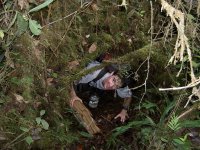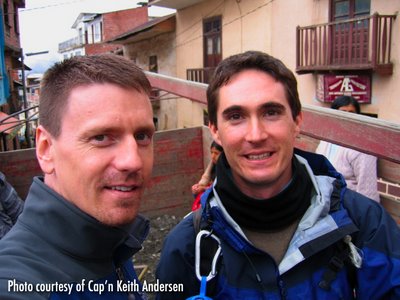[Our web connection is back today, but it's dicey to say the least. So this is as much as I've been able to get online: most of the text and all but 2 or 3 of the photos from the trip I made this past Saturday and Sunday with Hugh's Tropical Ecology class.
¡Disfrutalo!]
If you look out any of the windows on the northeast side of our house, you see Uchumachi. Named after the male spirit that resides in it, it's a big wall of a mountain that defines the edge of our valley. Plenty of visitors have looked at it longingly (it is beautiful, with a few sheer rock scars on the its side that help give scale to the trees that cover the rest.) But I'm not going to let anybody even look at it without considering a few of the following details of our hike up it this weekend . . .

Three students from Hugh's courageous
Ecología Tropicál class led us up (and set our near-break-neck pace) with machetes to clear the way. We wouldn't have made it without them, and the wreckage left in their wake was fascinating: palm trunks sliced open to reveal their intricate innards, ferns scattered beneath your feet (making it less muddy, but more dangerous in terms of seeing the best place to place your weight), as well as half-julienned branches that seized every opportunity to deliver an unwelcome bear hug to dangling boot laces.

We were walking on what can best be called a "suspended sponge path" -- a mischievous concoction of roots, moss, old branches, mud, rain, bugs, and . . . um . . . pure unadulterated evil. And it wasn't flat either. Here's a picture of what was probably a 6-8 foot drop off we had just climbed up. You might start walking with care, testing the slippery, mossy surface for its ability to hold you and your pack. . . but within 30 minutes of our high speed 6 hour climb, you knew the only way to get where you were going in any reasonable amount of time was to throw caution to the wind and hope for the best. And it worked often enough to keep you convinced that it was a good plan. But when it didn't, you were in deep trouble. More than once, a vine insinuated itself intractably around one foot just in time for the other to plunge knee-deep into the sponge path.

What we were walking
through is worth noting too. Tree-spelunking is the term I coined for it. (Here's a photo -- remember that inviting path on the other side of this mossy branch is waiting for you to step a few inches too short or long so it can drag your sad sorry foot halfway across the river Styx. Or something like that.)
I have a deep affection for the
mochilla roja y negra that's hauled my gear on 7 continents -- but apparently so does the cloud forest. The straps, the zipper danglies, the pack itself and especially the small top section were all subjected to the molestation of vines and branches. Once it became so stuck in fact, that Daniel had to machete me out. Thankfully he was behind me and so I didn't know (until suddenly I had forward momentum again) that there was 3 feet of razor-sharp machete blade doing a liberation dance within inches of me.

Here's another photo showing some tree-spelunking in action. (I'm carrying the precious plant press that seemed less and less precious in my eyes as the climb progressed.)
I was the 'sweep' hiker on both the way up and the way down. Perhaps this was because I had the first aid kit (which I ended up being the only person needing) but more likely it was because I was the slowest. Taking pictures didn't help my pace, but that wasn't the only factor. None of the supremely good-natured students complained (at least not within earshot in Spanish or English) so I had time to contemplate the assorted costs and benefits of being last. On the way up, the path was theoretically as wide and navigable as it was ever going to be (the product of the 8 people ahead of me.) But on the way down, most all the branches that couldn't support a human were already busted. Taking into consideration the springiness, sponginess, mossiness, and evilness of the path, most said broken roots and low branches mercilessly reassumed their unbroken appearance: I was pretty sure I heard the wiry little trees cackle with shadenfreude. I was often too far behind to hear if any of my
compañeros were joining in. Directly in front of me, though, was Mela -- a sweet student who thoughtfully sent back a rhythmic chorus of
"No toca; no toca tampoco" anytime we got within stumbling distance of trees with cruel spines -- spines often hidden in soft friendly-looking moss. (And yes, I do mean 'stumbling distance' literally.)

The point of our hike was to collect soil and insect samples. Just a few meters from our hard-won camp site, Hugh dug down through a foot of spongy organic material before reaching soggy clay the students could examine and hypothesize about.
Students tracked down crazy-small orchids, tall wispy trees with shallow gnarly roots, and the plant whose sap we use for incense in church.

They also captured and anesthetized bugs: tiny gnats, bully-sized flies, and an impossibly flat centipede that nearly got lost inside a single paper towel.
(Please don't ask me to remember how we drew flies and beetles -- though it did involve me learning that waxy leaves give a clean impression but don't make for a clean wipe.)

Uchumachi is
siempre nublada so when we got the rare chance to look down below us into the valley, we took it. The blazing mid-day high-altitude sun washes the view out considerably, but it was inspiring nonetheless.
There are lots of ways to respond to non-fatal pain. And I suppose laughing uncontrollably is as good as any other option. Now that I'm back, I've been laughing all morning: my muscles are as sore as I can ever remember them. I feel like an old man, and take only cold comfort in the fact that my tent mates Saturday night were flabbergasted that I am 32, not 25 or 26. It was only in my retelling the part of the story where Hugh's jeans ripped open in the butt after his own 3 meter tumble, that my housemates deduced the fall as the reason every muscle of my body is itself scoffing at my attempts to motor around the two floors of our house. A thorough rehydration plan seems to be putting a dent in the pain level, but nothing is affecting my sense that I can't get away in my 30s with what I did without a thought in my 20s.
So about that 3 meter slip: it was at the very end of the trail (we found a shortcut at the end that shaved off 20 minutes or so) and so neither or bodies nor our minds were at their best. Hugh survived the surprise drop off but recommended everybody else shimmy down to the angular side of it. This was, for the record, exactly my plan. But the dirt-surfing I did to get to where I should have turned resulted in a little more speed than I had expected. So I faced that classic decision: grasp at whatever might slow me down (paltry grass with roots no deeper than an inch or two) or just go for it and plunge ahead. I plunged ahead, not actually knowing how far I was about to fall. Let's just say it was a rocky, dusty, bone-jarring surprise. I managed to stand up from the ditch I fell into and holler out
"Éxito!" but soon after claiming success, my legs registered the shock and my hands registered the cuts. I'm fine of course -- my pants didn't rip and I was still able to walk the remaining mile or two home with my pack, but I think my dirt-surfing career is over. (And no, I don't have a photo of the drop off, but here's one on the nice wide road that leads home from there to Carmen Pampa to prove that we were OK.)

 "¿La Maria?"
"¿La Maria?" 



















